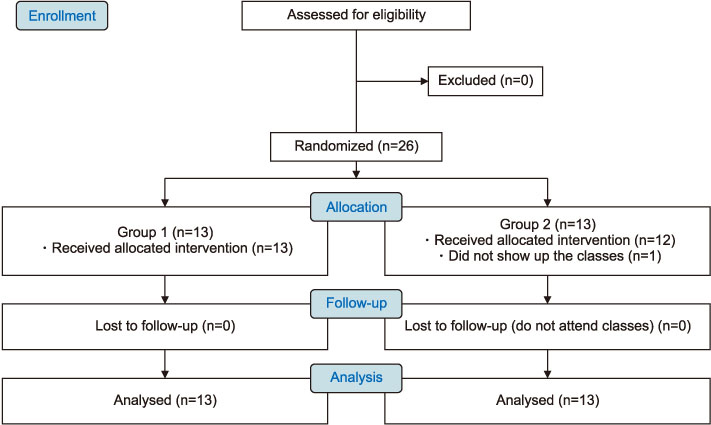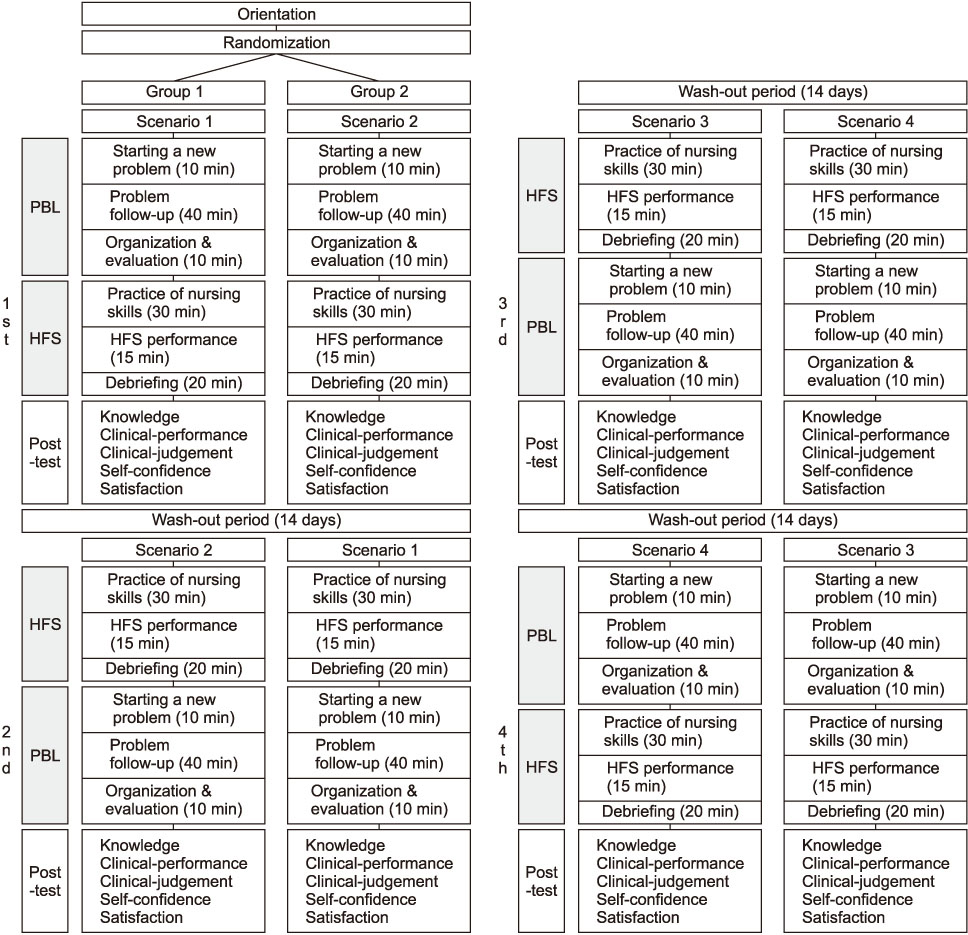J Korean Acad Nurs.
2019 Feb;49(1):92-103. 10.4040/jkan.2019.49.1.92.
A Comparative Study on Learning Outcomes according to the Integration Sequences of S-PBL in Nursing Students: Randomized Crossover Design
- Affiliations
-
- 1College of Nursing, Chonnam National University, Gwangju, Korea. choijy@jnu.ac.kr
- KMID: 2440390
- DOI: http://doi.org/10.4040/jkan.2019.49.1.92
Abstract
- PURPOSE
This study aimed to compare the effects of simulation integrated with problem based learning (S-PBL) according to the sequences of problem-based learning (PBL) and high fidelity simulation training (HFS) on knowledge, clinical performance, clinical judgment, self-confidence, and satisfaction in fourth-grade nursing students.
METHODS
In this randomized crossover design study, four S-PBLs on medical-surgical nursing were applied alternatively to two randomly-assigned groups of 26 senior nursing students for 8 weeks. The collected data were analyzed using an independent t-test.
RESULTS
The method of administering PBL prior to HFS led to significantly higher scores on knowledge (t=2.28, p=.025) as compared to the method of administering HFS prior to PBL. However, the latter method led to significantly higher scores on clinical performance (t=−6.49, p < .001) and clinical judgment (t=−4.71, p < .001) as compared to the method of administering PBL prior to HFS. There were no differences in the effect of the two methods on self-confidence (t=1.53, p=.128) and satisfaction (t=1.28, p=.202).
CONCLUSION
The integration sequences of S-PBL was associated with different learning outcomes. Therefore, when implementing S-PBL, it is necessary to consider the educational goal to executes an appropriate sequence of integration.
MeSH Terms
Figure
Cited by 1 articles
-
Comparison of Neck Pain, Shoulder Pain, and Comfort between Buckwheat and Latex Pillows
Ji-Soo Lee, Soo-Kyoung Lee
Korean J Health Promot. 2019;19(2):107-113. doi: 10.15384/kjhp.2019.19.2.107.
Reference
-
1. Murphy S, Hartigan I, Walshe N, Flynn AV, O’Brien S. Merging problem-based learning and simulation as an innovative pedagogy in nurse education. Clinical Simulation in Nursing. 2011; 7(4):e141–e148. DOI: 10.1016/j.ecns.2010.01.003.
Article2. Barrows HS. Problem-based learning in medicine and beyond: A brief overview. New Directions for Teaching and Learning. 1996; (68):3–12. DOI: 10.1002/tl.37219966804.
Article3. Jeffries PR. A framework for designing, implementing, and evaluating simulations used as teaching strategies in nursing. Nursing Education Perspectives. 2005; 26(2):96–103.4. Roh YS, Cho ES, Lee WS. Analysis of main instructional design factors for simulation integrated PBL nursing courses. The Journal of Educational Information and Media. 2010; 16(1):125–143.5. Liaw SY, Chen FG, Klainin P, Brammer J, O’Brien A, Samarasekera DD. Developing clinical competency in crisis event management: An integrated simulation problem-based learning activity. Advances in Health Sciences Education: Theory and Practice. Advances in Health Sciences Education: Theory and Practice. 2010; 15(3):403–413. DOI: 10.1007/s10459-009-9208-9.6. Kang KA, Kim S, Kim SJ, Oh J, Lee M. Comparison of knowledge, confidence in skill performance (CSP) and satisfaction in problem-based learning (PBL) and simulation with PBL educational modalities in caring for children with bronchiolitis. Nurse Education Today. 2015; 35(2):315–321. DOI: 10.1016/j.nedt.2014.10.006.
Article7. Kim M, Shin M. Development and evaluation of simulation-problem–based learning for sex education. Computers, Informatics, Nursing. 2016; 34(1):17–25. DOI: 10.1097/CIN.0000000000000200.
Article8. Roh YS, Kim SS, Kim SH. Effects of an integrated problem-based learning and simulation course for nursing students. Nursing & Health Sciences. 2014; 16(1):91–96. DOI: 10.1111/nhs.12069.
Article9. Park SJ, Ji ES. A structural model on the nursing competencies of nursing simulation learners. Journal of Korean Academy of Nursing. 2018; 48(5):588–600. DOI: 10.4040/jkan.2018.48.5.588.
Article10. O’Donnell JM, Decker S, Howard V, Levett-Jones T, Miller CW. NLN/Jeffries simulation framework state of the science project: Simulation learning outcomes. Clinical Simulation in Nursing. 2014; 10(7):373–382. DOI: 10.1016/j.ecns.2014.06.004.
Article11. Wotton K, Davis J, Button D, Kelton M. Third-year undergraduate nursing students’ perceptions of high-fidelity simulation. Journal of Nursing Education. 2010; 49(11):632–639. DOI: 10.3928/01484834-20100831-01.
Article12. Wimmer MJ, Wilks DH, Grammer RW, Doerr RG, Summers DE, Ressetar HG. Use of patient simulation in problem-based learning for first-year medical students. Medical Science Educator. 2014; 24(3):253–261. DOI: 10.1007/s40670-014-0045-y.
Article13. Riley RH. Manual of simulation in healthcare. 2nd ed. New York: Oxford University Press;2016. p. 221–234.14. Tschannen D, Aebersold M, Sauter C, Funnell MM. Improving nurses’ perceptions of competency in diabetes self-management education through the use of simulation and problem-based learning. The Journal of Continuing Education in Nursing. 2013; 44(6):257–263. DOI: 10.3928/00220124-20130402-16.
Article15. Maxwell NL, Mergendoller JR, Bellisimo Y. Developing a problem-based learning simulation: An economics unit on trade. Simulation & Gaming. 2004; 35(4):488–498. DOI: 10.1177/1046878104264789.
Article16. Kim JH, Park IH, Shin S. Systematic review of Korean studies on simulation within nursing education. The Journal of Korean Academic Society of Nursing Education. 2013; 19(3):307–319. DOI: 10.5977/jkasne.2013.19.3.307.
Article17. Adamson K. A systematic review of the literature related to the NLN/Jeffries simulation framework. Nursing Education Perspectives. 2015; 36(5):281–291.
Article18. Alfaro-LeFevre R. Critical thinking, clinical reasoning, and clinical judgment: A practical approach. 5th ed. St. Louis (MO): Elsevier Saudnders;2013. p. 66–75.19. Todd M, Manz JA, Hawkins KS, Parsons ME, Hercinger M. The development of a quantitative evaluation tool for simulations in nursing education. International Journal of Nursing Education Scholarship. 2008; 5(1):1–17. DOI: 10.2202/1548-923x.1705.
Article20. Lasater K. High-fidelity simulation and the development of clinical judgment: Students’ experiences. Journal of Nursing Education. 2007; 46(6):269–276.21. Shim K, Shin H. The reliability and validity of the lasater clinical judgement rubric in Korean nursing students. Child Health Nursing Research. 2015; 21(2):160–167. DOI: 10.4094/chnr.2015.21.2.160.
Article22. Jeffries PR, Rizzolo MA. Designing and implementing models for the innovative use of simulation to teach nursing care of ill adults and children: A national, multi-site, multi-method study [internet]. Washington, DC: National League for Nursing and Laerdal Medical (US);c2006. cited 2016 Feb 15. Available from: http://www.nln.org/docs/default-source/default-document-library/instrument-2_satisfaction-and-self-confidence-in-learning.pdf?sfvrsn=0.23. Lasater K. Clinical judgment: The last frontier for evaluation. Nurse Education in Practice. 2011; 11(2):86–92. DOI: 10.1016/j.nepr.2010.11.013.
Article24. Bowling AM, Underwood PW. Effect of simulation on knowledge, self-confidence, and skill performance in the USA: A quasi-experimental study. Nursing & Health Sciences. 2016; 18(3):292–298. DOI: 10.1111/nhs.12267.
Article25. Shinnick MA, Woo M, Horwich TB, Steadman R. Debriefing: The most important component in simulation? Clinical Simulation in Nursing. 2011; 7(3):e105–e111. DOI: 10.1016/j.ecns.2010.11.005.
Article26. Li J, Li QL, Li J, Chen ML, Xie HF, Li YP, et al. Comparison of three problem-based learning conditions (real patients, digital and paper) with lecture-based learning in a dermatology course: A prospective randomized study from China. Medical Teacher. 2013; 35(2):e963–e970. DOI: 10.3109/0142159X.2012.719651.
Article27. Lavoie P, Cossette S, Pepin J. Testing nursing students’ clinical judgment in a patient deterioration simulation scenario: Development of a situation awareness instrument. Nurse Education Today. 2016; 38:61–67. DOI: 10.1016/j.nedt.2015.12.015.
Article28. Kelly MA, Hager P, Gallagher R. What matters most? Students’ rankings of simulation components that contribute to clinical judgment. Journal of Nursing Education. 2014; 53(2):97–101. DOI: 10.3928/01484834-20140122-08.
Article29. Lee WS, Kim M. Effects and adequacy of high-fidelity simulation-based training for obstetrical nursing. Journal of Korean Academy of Nursing. 2011; 41(4):433–443. DOI: 10.4040/jkan.2011.41.4.433.
Article30. Bussard ME. Postdebriefing activities following simulation. Teaching and Learning in Nursing. 2017; 12(3):220–222. DOI: 10.1016/j.teln.2017.03.010.
Article
- Full Text Links
- Actions
-
Cited
- CITED
-
- Close
- Share
- Similar articles
-
- Development and Implementation of Problem-based Learning Packages on the Respiratory and Cardiac System
- The Effects of PBL (Problem-Based Learning) on the Self-Directed Learning, Critical Thinking Disposition, and Problem Solving Process of Nursing Students
- Effects of Problem-Based Learning Combined with Simulation on the Basic Nursing Competency of Nursing Students
- The Effects of PBL(Problem-Based Learning) on the Metacognition, Critical Thinking, and Problem Solving Process of Nursing Students
- An Example of Development and Application of PBL Package




